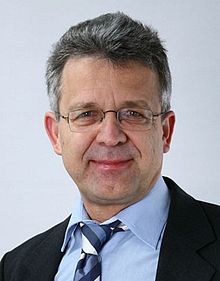Martin Aeschlimann
Martin Aeschlimann (born August 12, 1957 ) is a Swiss physicist . He is Professor of Experimental Physics in the Physics Department at the Technical University of Kaiserslautern and, since 2008, spokesman for the State Research Center for Optics and Materials Science (OPTIMAS) .
Academic career
Martin Aeschlimann studied experimental physics at the ETH Zurich from 1980 to 1985 and received his doctorate there in 1989 on the subject of Magnetism at Surfaces and Ultrafast Magnetization Reversal Studies with Spin-Polarized Photoemission. From 1985 to 1989 he was an assistant at the laboratory for solid state physics with Hans Christoph Siegmann at the ETH Zurich. From 1989 to 1990 Aeschlimann held a postdoctoral position at the National Institute of Standards and Technology , Washington, DC , USA. The following year he became a Research Associate at the NSF Center for Photoinduced Charge Transfer at Rochester University . From 1993 to 1998 he was a research assistant at the Laboratory for Technical Chemistry at the ETH Zurich. In November 1996 he completed his habilitation on Time Resolved Studies of Electron Relaxation at Metal Surfaces and was then appointed professor for experimental physics at the University of Essen in April 1998 . In July 2000 he moved to the Technical University of Kaiserslautern . From 2008–2015 he was the spokesman for the priority program 1391 Ultrafast Nanooptics of the German Research Foundation . Since 2008 he has been the spokesman for the State Research Center for Optics and Materials Science (OPTIMAS) and from 2016 the spokesman for the Collaborative Research Center / Transregio 173 Spin + X: Spin in its collective environment of the German Research Foundation. Since 2015 he has also been the spokesman for the Laboratory for Advanced Spin Engineering (LASE), a research building at the Technical University of Kaiserslautern within the framework of funding under Article 91b of the Basic Law for the Federal Republic of Germany with half of the funding from the State of Rhineland-Palatinate. From 2015 to 2018 he is the elected spokesman for the Condensed Matter Section (SKM) of the German Physical Society (DPG) . The section represents more than 18,000 members in 13 professional associations. Aeschlimann has been a member of the editorial board of the New Journal of Physics since 2009 .
research
Martin Aeschlimann's research area includes ultrafast phenomena in solids, on surfaces, at interfaces and in nanostructures. The focus is on the investigation of the dynamics of electrons , plasmons , phonons and spins on fundamental time and length scales. The experimental measurement methods for the investigation of ultra-fast dynamic processes in real time with high temporal and spatial resolution are continuously being further developed. Martin Aeschlimann basically combines measuring methods with ultra-fast laser pulses with methods of surface physics, nano-optics and magnetism . Current fields are the time-resolved photoemission (ARPES, PEEM, pulse microscopy) and time-resolved magneto-optical effects using lasers in the visible spectrum of light and in the soft X-ray range.
Awards
- Profil-II Prize of the Swiss National Science Foundation (SNSF)
Publications
Aeschlimann has published more than two hundred scientific publications in refereed international journals.
Web links
Individual evidence
- ↑ State Research Center OPTIMAS Technical University Kaiserslautern: Members.
- ^ Time Resolved Studies of Electron Relaxation at Metal Surfaces. In: Phys. Rev. B 50, 8957 (1994).
- ↑ DFG - German Research Foundation: Ultrafast Nanooptics.
- ^ Literature by and about Martin Aeschlimann in the catalog of the German National Library
| personal data | |
|---|---|
| SURNAME | Aeschlimann, Martin |
| BRIEF DESCRIPTION | Swiss physicist |
| DATE OF BIRTH | August 12, 1957 |
